Embarking on a bikepacking adventure blends the thrills of multi-day biking trips with the self-reliant aspect of camping. Creating an experience that is both challenging yet immensely rewarding.
Central to a successful bikepacking journey is understanding the crucial element of supplies, specifically water. Knowing exactly how much to carry, the consequences of inadequate hydration, and how to obtain and purify water from natural sources is extremely important.
Your water needs can greatly vary depending on the length and nature of the trip, the intensity of exertion, and individual factors. Equally important is leveraging the right water-carrying systems, each with its unique trade-offs.
By delving into the principles of human hydration and a thorough understanding of water management strategies, you can confidently embark on your bikepacking adventure, equipped with the knowledge for a safe and enjoyable journey.
Simply put, short bike rides always need a liter of water. Day trips need around 2 liters. Overnight rides need between 2 and 4 liters. Anything longer than that should have 4 liters plus water purification methods.
Types of Bikepacking Trips
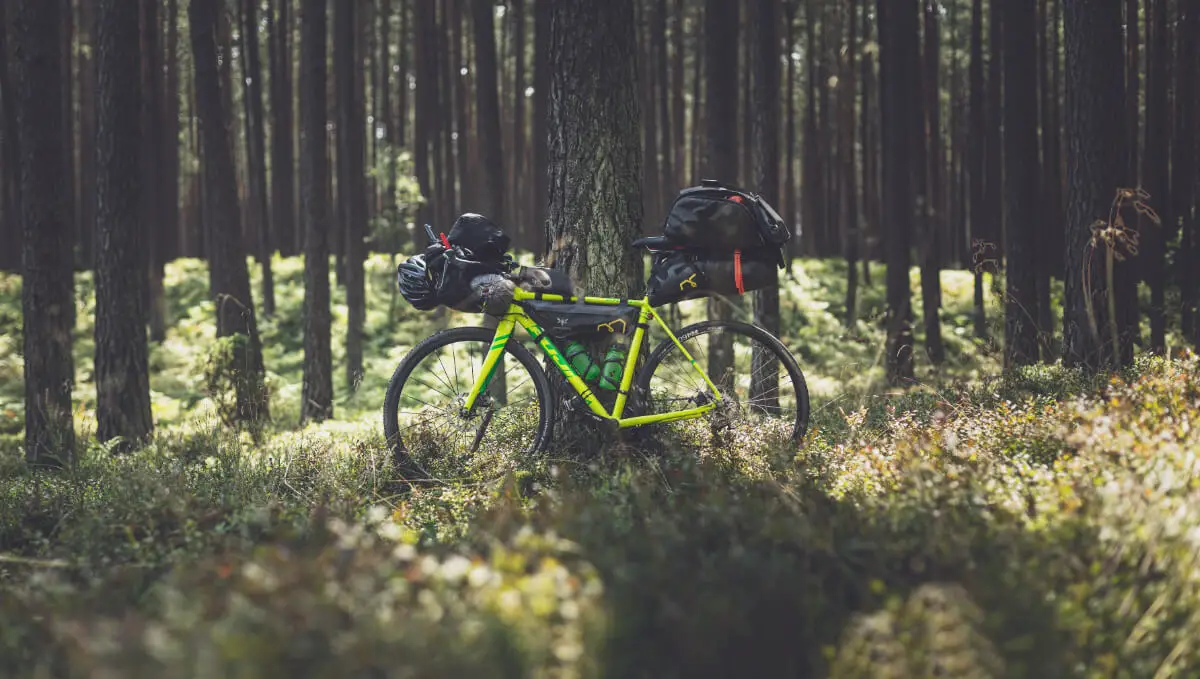
Generally, bikepacking trips are categorized into three types: day trips, overnight trips, and long-term trips. Some regular mountain bikers will go on day trips without considering it bikepacking.
Day trips require minimal supplies because they typically only last several hours. However, the exertion is normally much higher and you’ll need energy and hydration throughout the day. It’s important to carry enough water.
Overnight trips may last a weekend or several days. Water needs will escalate in quantity and importance for these ventures. You’ll need to hydrate, cook, and possibly clean with water during your trip. The weight of your water may start to become an issue when starting out on trips like this.
Long-term trips are extended ventures that could stretch out over multiple weeks or even months. These are rare and require the most preparation regarding water needs due to the extended duration and potential for varying weather conditions.
Determining Water Needs Based on Trip Type
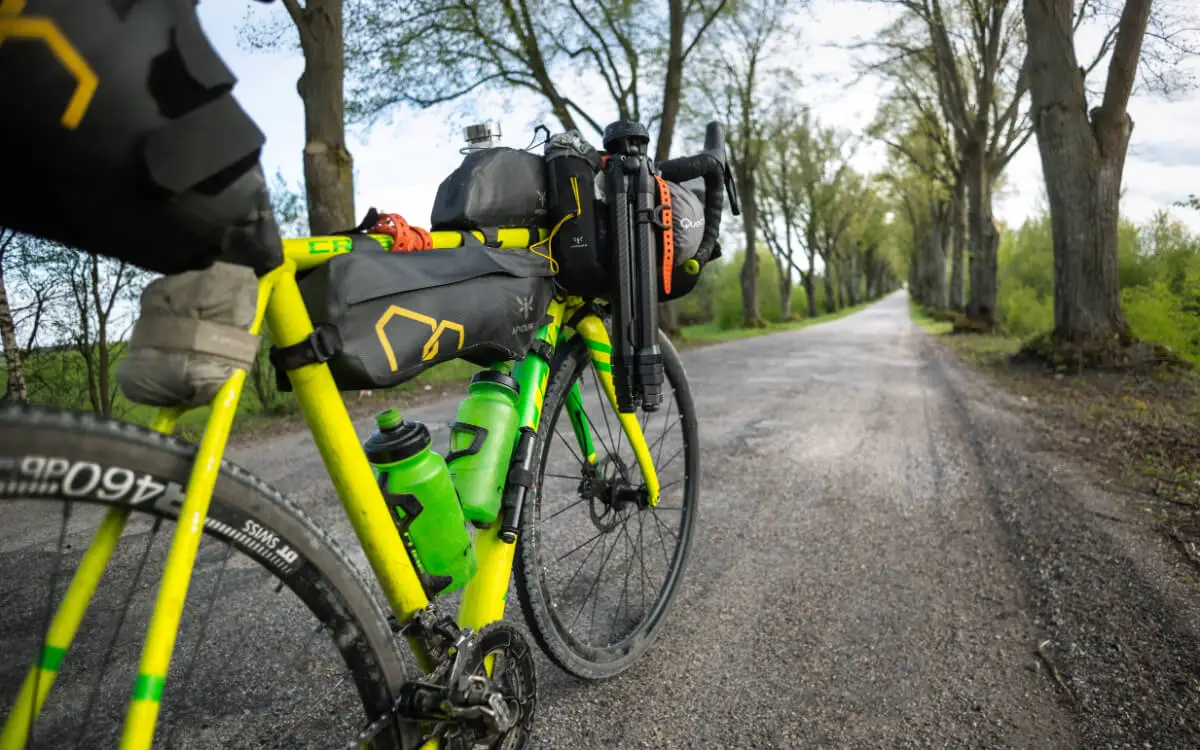
Your water needs when bikepacking largely depend on the type of trip you’re planning.
It doesn’t really count as bikepacking but any sort of cycling trip needs water. Even if you’re only going out for a few hours, 1 liter of water is essential.
For day trips, you should carry at least one to two liters of water. However, this could depend on the weather and climate. If there is heavy exertion planned or prolonged heat exposure, your water requirements might increase.
On overnight trips, you’ll need water not only for hydration but also for cooking meals and possibly cleaning. Therefore, carrying between two to four liters of water per day is a safe guideline. Always take into consideration the availability of water sources along your route where you can refill when needed.
When you get over 2 liters you need to start thinking about weight. Anything too heavy will start to increase exertion and thus water usage.
For long-term biking trips, water needs may continue to rise due to an increase in physical exertion and a potential lack of reliable water sources. In this case, carrying between four to six liters per day may be necessary.
Pre-planning your route to determine where water sources are located is essential for a successful longer term bikepacking trip. Also, always carry a water purification method to ensure the water you find on your trip is safe to consume.
Remember, maintaining proper hydration is pivotal for any bikepacking journey. Always err on the side of having too much water than not enough. As weather conditions, physical exertion, and altitude can drastically alter how much water your body needs, it’s always better to overestimate your water needs while planning for your bikepacking adventure.
Understanding the Need for Hydration
Human beings, regardless of their levels of physical activity, require a significant amount of water intake daily. This is largely due to the fact that the human body is made up of 70% water, a vital resource used in various bodily functions, like digestion, circulation, and temperature regulation.
Female adults need about 2.2 liters (9 cups) of water daily, while male adults should aim for about 3 liters (13 cups). It’s important to note that these values include all fluids consumed, not just pure water.
Impacts of Dehydration
Dehydration is a condition caused by inadequate water intake, and can occur if an individual fails to replenish the water lost through breathing, sweating or urination.
Common early symptoms of mild dehydration include thirst, dry mouth, tiredness, and lessened urine output. If dehydration intensifies, symptoms can escalate to confusion, rapid heartbeat, fever or even unconsciousness.
Lack of sufficient hydration can also lead to persistent health problems such as kidney stones and urinary tract infections.
The Relationship Between Physical Activity and Hydration
Physical activities, including cycling and bikepacking, contribute significantly to water loss in the body, leading to an increased need for hydration.
While biking, the body sweats to cool down, which leads to water loss and the possible onset of dehydration. Thus, bikers should ensure they increase their water consumption to support their bodies during physical exertion.
Furthermore, activities in hotter environments enhance sweating, heightening the chances of water loss and dehydration.
Hydration Tips for Bikepacking
On average, during regular bike riding conditions, it’s recommended to drink about 500ml to 750ml (17oz to 25oz) of water per hour of biking.
However, because bikepacking often involves extended periods of cycling and potentially challenging weather conditions, bikers may need to increase this intake.
A general rule of thumb can be to consume an extra 500ml of water for each hour of cycling under these conditions.
Always remember that personal hydration requirements may vary based on individual sweat rates, the intensity of physical activity and the weather conditions. Additionally, bikers should also consider refueling on electrolytes during biking, as sweat loss not only reduces water in the body but essential salts as well.
Avoid reaching a point of thirst before drinking, as thirst is an indication that dehydration has already started. Instead, aim to consume small amounts of fluids regularly throughout the cycling trip.
Water Bottles: Easy Access, Limited Capacity
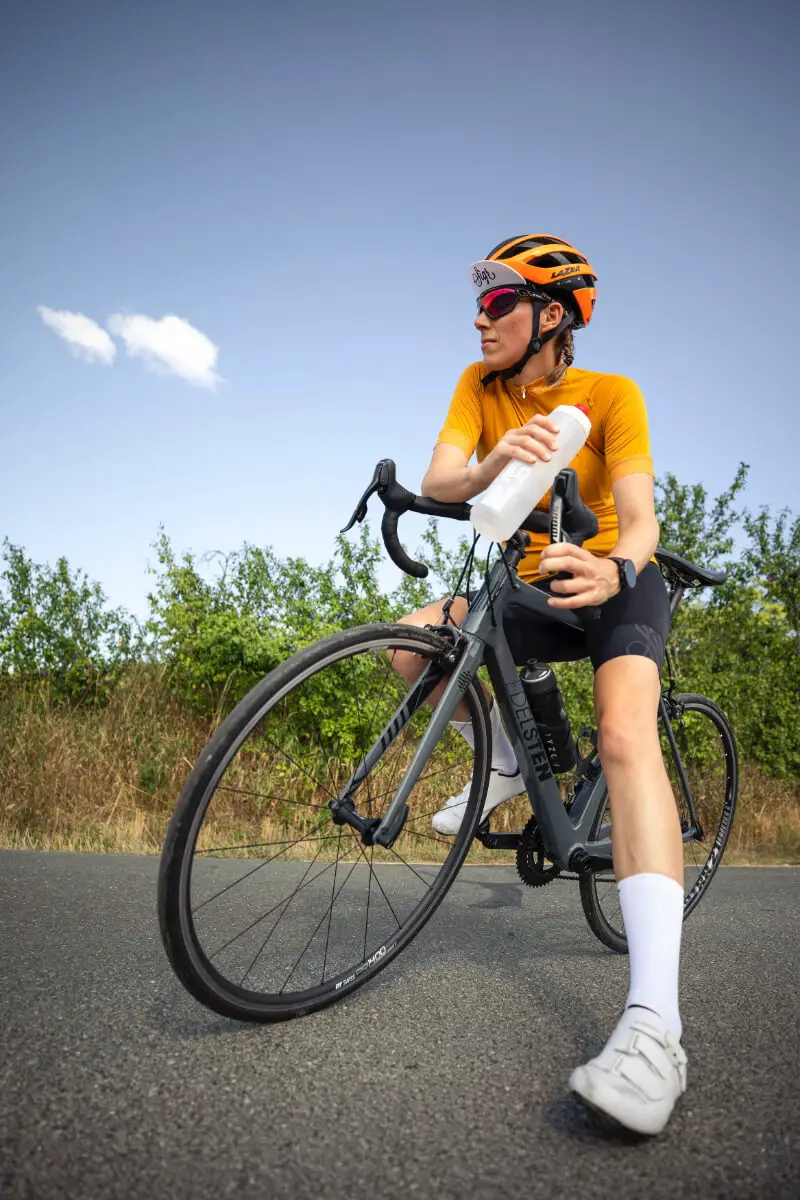
One of the most common methods of carrying water while bikepacking is to use water bottles. They’re straightforward to use and allow for quick, on-the-go hydration. Moreover, they’re relatively lightweight and easy to refill.
Typically, bikepacking bikes have special spots to hold one or two water bottles, increasing accessibility while riding.
However, water bottles come with some downsides. They have a limited capacity, usually holding only about 0.5 to 1 liter of water each. It means they might not provide enough hydration for particularly long or hot rides.
Also, depending on the bike’s design, accessing and stowing water bottles while riding can sometimes be awkward.
Hydration Packs: Large Capacity, Comfortable, Versatile
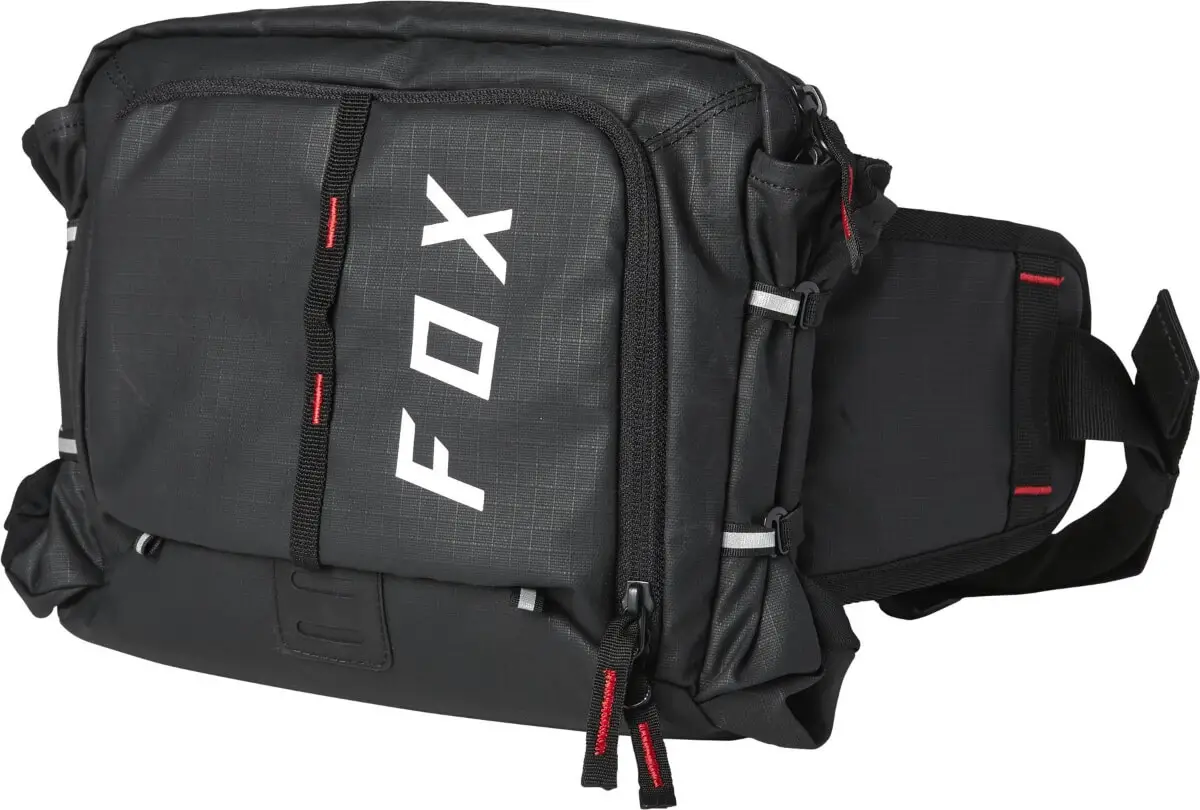
![]() Photo by tredz.co.uk
Photo by tredz.co.uk
Another popular option for bikepackers is a hydration pack. These backpack-style carriers usually have a larger water capacity than traditional water bottles, often ranging from 1.5 to 3 liters. This increased capacity can make a significant difference on long rides or multi-day trips.
In terms of usability, hydration packs provide a hands-free drinking system that is comfortable and convenient for continuous hydration without stopping. Plus, most packs have extra space for carrying gear and snacks.
Despite these benefits, hydration packs do have some drawbacks. They add weight to the rider’s upper body, which can lead to discomfort and fatigue on long rides.
Cleaning the reservoir and tube can be difficult and if not done correctly, can lead to bacterial growth. Additionally, they can contribute to the rider’s perspiration, as the back is less exposed to airflow.
External Carriers: High Capacity, Bulky
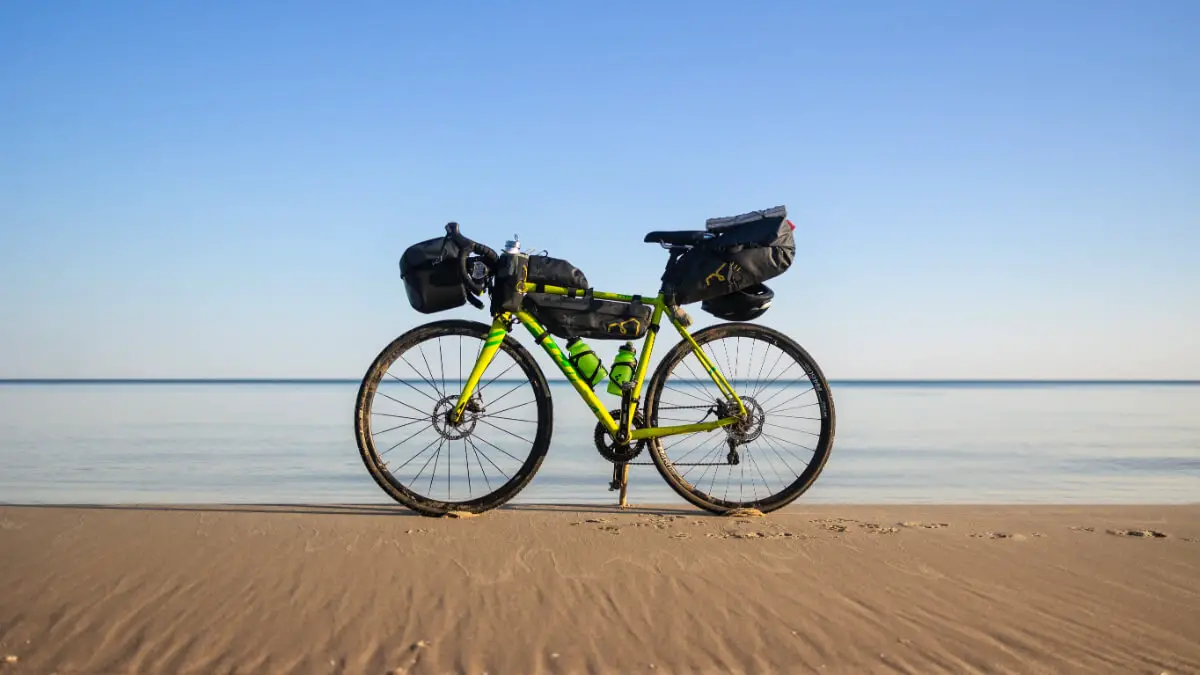
External carriers such as cargo cages or harnesses attached to the bike can enable riders to carry large water cans or other bulky water containers. They offer a high capacity option, which is particularly valuable in arid areas where water sources are sparse. A 4-liter water container, for example, can keep a rider hydrated for an extended period.
However, this method also has its disadvantages. External carriers add weight to the bike, making it harder to handle. They can also interfere with the bike’s balance if not properly loaded.
Plus, reaching and replacing large containers while riding can be challenging, and they’re generally more cumbersome to refill than bottles or hydration packs.
Plan According to Your Needs
When deciding how to carry water on your bikepacking trip, it’s essential to consider factors such as the length of your ride, expected weather conditions, availability of water sources along the route, and your comfort.
While water bottles provide quick access to water, hydration packs offer larger capacity and are more comfortable for some riders.
External carriers provide the highest capacity but at the cost of handling and balance.
A combination of methods may be your best bet for staying hydrated on the trail.
Water Sources and Purification on the Trail
Identifying Safe Natural Water Sources on the Trail
When bikepacking, you should be aware of where to find safe, drinkable water. Ideal sources of water can include rivers, lakes, streams, springs, and glaciers. However, not all water sources are safe.
Avoid stagnant or murky waters, and steer clear of water that’s near human habitation or agricultural lands, as these sources could be contaminated with harmful substances, bacteria and viruses.
Moving water is typically safer than standing water; the flow helps to filter out potential contaminants. Always take water from the surface of the source and not the bottom, where harmful particles are more likely to settle.
Filtration Systems
One of the most popular methods of water purification among bikepackers is using a filter system. These systems work by physically removing harmful protozoa, bacteria, and often viruses from the water.
Some systems involve pumping water through a filter, while others allow you to drink directly from a water source via a filtered straw. Be sure to follow the instructions on the packaging carefully for the most effective result.
Boiling Water
Boiling water is the most surefire way to purify it, as the heat kills many types of bacteria, viruses, and parasites.
The trick, however, is having the time and resources to do so while on the trail.
If you choose to boil water, ensure it comes to a rolling boil for at least one minute. In higher altitudes above 2,000 meters (about 6,500 feet), boil the water for three minutes to ensure safety.
Purification Tablets
Another popular method of purification is using purification tablets or drops. They work by dissolving into the water and killing many types of harmful microorganisms.
They’re lightweight, easy to pack, and therefore ideal for bikepacking adventures. The taste of the water after treatment might not be the best, but it’s safe to drink.
Ensure you follow instructions on the packaging for dosage and waiting time.
How Much Water to Take When Bikepacking?
The recommended daily intake of water per day is around 3 liters for men and 2.2 liters for women according to the U.S. National Academies of Sciences, Engineering, and Medicine.
However, you should take into account the weather, trail difficulty, and your personal hydration needs when bikepacking. Plan and map out water refill opportunities in advance to avoid carrying too much water at once, as water is heavy and can greatly affect the weight of your pack.
Ultimately, mastering the art and science of water management in bikepacking is about more than just staying hydrated. It’s about learning to harness the resources around you, making informed judgments, and maintaining a state of self-reliance even in less-than-ideal conditions.
Whether it’s strategizing how to utilize your bottle and hydration pack capacities intelligently or knowing when and how to purify a running stream, the skills you develop along the way will contribute to a more enriching and self-sustainable biking journey.
Bikepacking, at its core, is about the stories we make, the challenges we overcome, and the knowledge we gather. And with each drop of water we consume, the narrative of our adventure unfolds — one pedal, one vista, one campsite, and one sunrise at a time.


